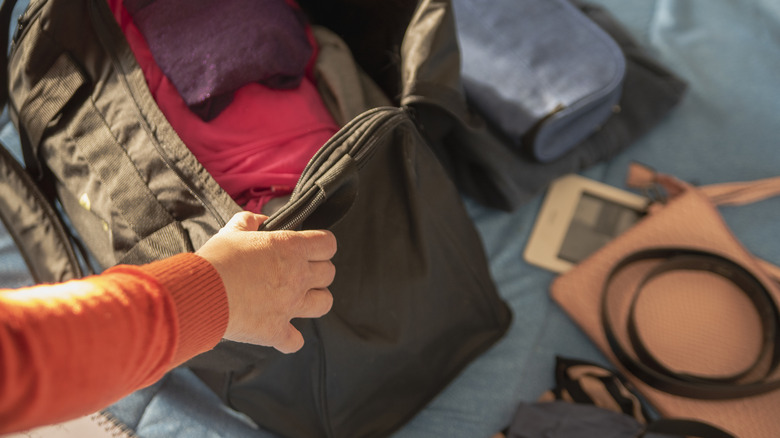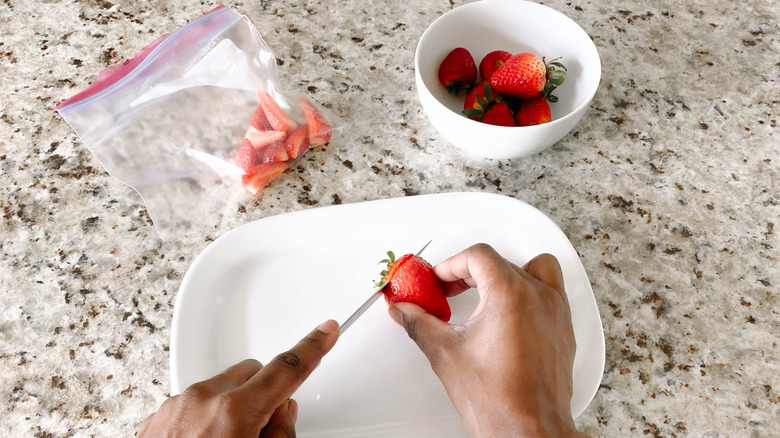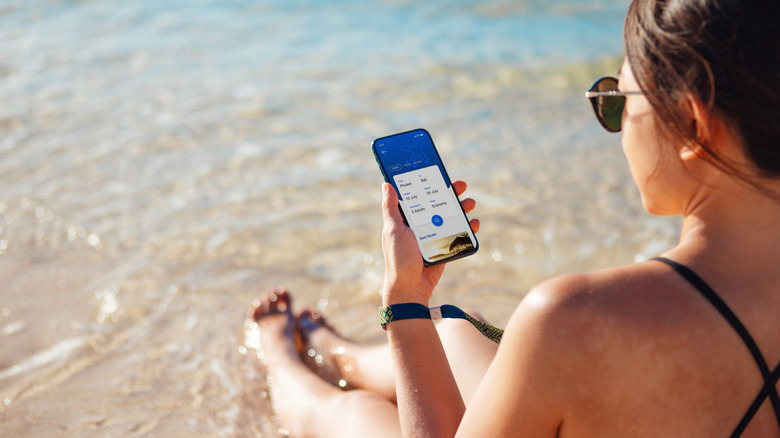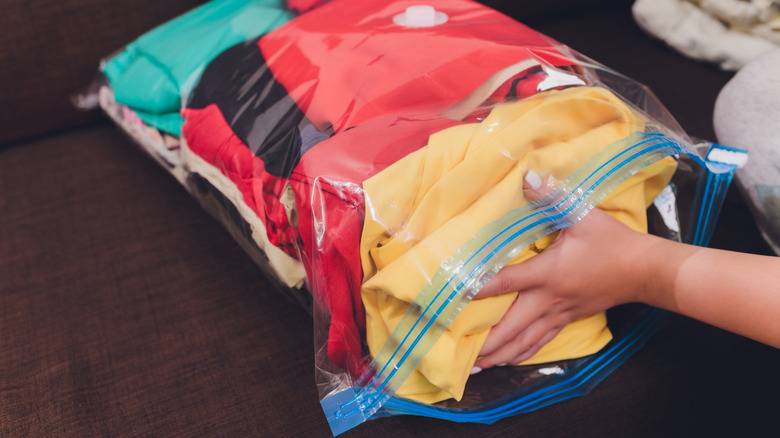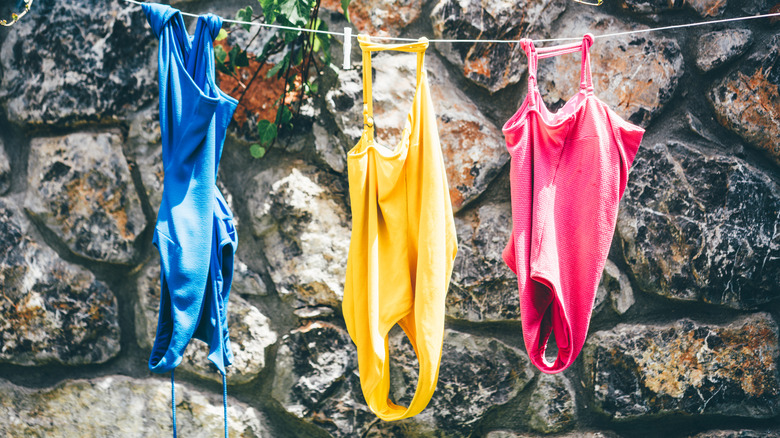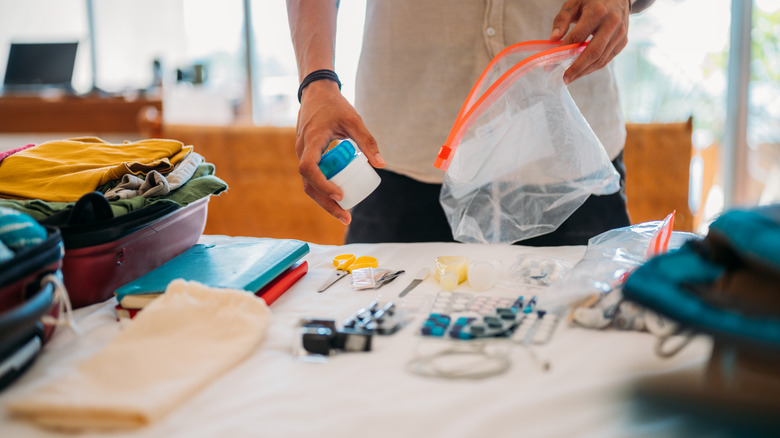The Essential Item All Tourists Need In Their Carry-On (And The 5 Reasons Why)
For seasoned travelers, packing is a sacred ritual honed by years of experiences, mishaps, and lessons. Some swear by the power that certain objects can bring to traveling, whether it's packing a second phone when on vacation or always having a scarf on hand for its multiple uses. But it is the humble Ziploc bag that often makes the cut in many a tourist's carry-on bags.
Unexpected? Not really. Transparent, affordable, and lightweight, this ubiquitous household item is a lifesaver when traveling, so much so that it's been integrated into the TSA's 3-1-1 liquids rule (where containers of 3.4 ounces of liquid should be placed in one quart-sized resealable bag per person). But aside from being used to comply with the TSA, even travel experts won't be caught without it: Travel pros like Samantha Brown call the Ziploc bag an unexpected essential item for carry-on luggage. Whether you're using it to store leftover food from a breakfast buffet or as a clear compartment to keep your luggage organized, the versatility of the resealable plastic bag knows no bounds. Here are the five ways this essential item carries its weight in a carry-on.
You can store food and snacks in them
When you're looking at long stretches during travel — a long-haul flight, a lengthy layover, or an overnight train ride — having a Ziploc bag for food storage can be a lifesaver. Filling it with fruits, trail mix, or mini veggies to satisfy the munchies will not only have you snacking healthily while away from home, but will also save you from the exorbitant prices of airport food as well. Bring empty zippered bags as well to fill with local snacks at your destination.
Aside from travel snacks, these bags come in handy when storing or preserving leftover food while you're traveling, like keeping that pizza slice or half of a sandwich you couldn't finish for later. And let's not forget that extra uneaten muffin or apple from your hotel's breakfast buffet, which you'd like to snack on later in the day. If you're pondering what the etiquette is for sneaking some breakfast fare back to your room, Hotelleriesuisse Graubünden President Ernst Wyrsch tells TravelNews that while loading up on breakfast buffet items for the rest of your day isn't generally permitted, "hardly any host will refuse the request for a small snack from the breakfast buffet if he asked politely."
You can use Ziploc bags to protect your tech
Nothing puts a damper on a beach holiday like having your phone plop unceremoniously into the sea while you're taking that selfie. A survey by U.K. travel insurance company Staysure revealed that for every five travelers, one has lost or damaged a gadget during a trip. Proactively slipping your phone into a Ziploc bag if you're anywhere near a body of water can save you the headache of trying to resuscitate a drowned phone instead of sipping that poolside cocktail. In a pinch, plastic zipper bags are practical for keeping your phone dry if you're caught in a rainstorm or from being damaged by sand when you're at the beach. TikToker @sofiawardell goes the extra mile by burrowing her Ziploc-bagged phone and valuables in the sand under the corner of her beach blanket as a safety precaution, stating that "this will also keep them cool, and away from the sand and water."
Ever had to struggle with unwieldy lengths of charger cords or knotted cables? Use snack-sized resealable bags to keep cables neatly stored when traveling. This trick saves a lot of space in your carry-on as well. Finally, point-and-shoot cameras have delicate sensors that easily fall prey to dust or water drops. Wiping them off can leave smudges, which will unfortunately show up on all your holiday photographs. Slip your camera into a Ziploc bag when not in use to prevent this from happening. Some photographers suggest throwing a silica gel packet or two into the Ziploc bag with your camera. These moisture- and condensation-absorbing gel packets, usually found in boxes of new shoes or electronic products, can keep camera lenses from fogging over.
Resealable bags can help you save carry-on space
Say you want to travel with just a single carry-on and want to make sure everything fits. Packing cubes definitely help in this department, but if you want more compression and waterproofing, Ziploc bags, especially the gallon-sized ones, are economical alternatives. As Redditor u/rirez shared, "Ziplocks do 95% of what a packing cube does, for less, with more flexibility. If going this route, I prefer the kind with a sliding lock." Pack clothes into the plastic bags and close the top, leaving an inch unzipped. Flatten the plastic bag as best you can and roll tightly from the bottom, squeezing out the excess air before fully zipping the bag shut. The trick does the job at mimicking a compression bag.
The Ziploc bags can be reused later to separate clean clothes from used ones, keeping them hermetically sealed away from the rest of your bag's contents. And because they're transparent, it's easy to keep track of your clothes inventory. Use different-sized Ziploc bags to organize smaller items such as beach or sports gear, socks, and underwear.
Ziploc bags keep wet items isolated
Aside from its purpose for liquid storage during TSA checks, resealable bags are convenient for separating the wet from the dry in your luggage. Use Ziploc baggies to seal off your damp swimsuits, beach towels, or wet umbrellas. Pack a spare set of clothes (top, bottom, underwear, and socks) in case of accidental spills in the plane or while traveling — you can stuff the wet clothes inside the bag once you've changed. If you're traveling with babies, you can use plastic zippered bags to temporarily keep the scent of dirty diapers from infiltrating the rest of your bag until you've found a way to properly dispose of them. Or store extra pairs of shoes in them to prevent the dirty soles from touching the clean contents of your bag.
There's also nothing worse than a shampoo or lotion bottle exploding all over your clothes and electronics. Keep a resealable bag around to store your toiletries in one place. That not only includes liquids but also toothbrushes and other bathroom-related accessories like soap bars or razors that get damp when used.
Store valuables and medicine in them
You'll never know how freeing it is to pull out a plastic bag from your carry-on knowing that it serves a purpose — unless you try it out yourself, that is. Organizing and categorizing travel items into resealable bags is a game-changer for any seasoned traveler, and it can be a secret weapon when packing a suitcase as efficiently as possible. Store valuables like jewelry, watches, sunglasses, or cash in one resealable bag; passports, receipts, insurance cards, or any other important travel-related documents can be folded in another. You can easily pull them out of your bag and lock them away in your hotel room's safe when you're out exploring.
Then, compile all your medicines inside a clear reusable bag, making it easier to rummage through your pills in case of an emergency. You can even break down individual pills into mini two-inch plastic bags. (Make sure to keep a copy of your doctor's prescription inside the bag, in case you need it at customs, or if you need a refill.) In addition to medicine, throwing in some first aid kit items can't do any harm — a pair of tweezers, some gauze, and Band-Aids can be a lifesaver in case of small emergencies. And while we're on the topic of small emergencies, empty Ziploc bags can also be used as vomit bags if you encounter transport sickness.
